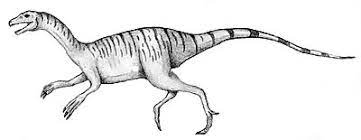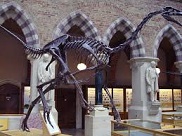
The discovery of Nqwebasaurus Dinosaur in the heart of sub-Saharan Africa marks a significant milestone in the field of paleontology. As one of the few theropods to be unearthed in this region, Nqwebasaurus presents a rare glimpse into the prehistoric world that once thrived on the African continent during the Early Cretaceous period, approximately 125 million years ago.
The story of Nqwebasaurus began with a paleontological expedition to the Eastern Cape Province of South Africa in 2000. The region's rich fossil deposits have long intrigued scientists, and this expedition proved no exception. Amidst layers of sediment, the remains of this enigmatic theropod were carefully uncovered, sparking excitement and curiosity among researchers.
| Name: | Nqwebasaurus dinosaurs |
| Size: | Around 2 to 3 meters |
| Main Facts: | Nqwebasaurus is one of the earliest theropods found in sub-Saharan Africa. |
The name Nqwebasaurus pays homage to the Nqweba Dam, a local landmark near the discovery site, linking the dinosaur to its geographic origins. As the scientific investigation unfolded, paleontologists revealed intriguing details about its anatomy, size, and potential ecological role.

Nqwebasaurus is a significant discovery in sub-Saharan Africa's paleontological history. This theropod dinosaur was unearthed in the Eastern Cape Province of South Africa during an expedition in 2000. As one of the few theropods found in this region, Nqwebasaurus sheds light on the prehistoric diversity that once thrived in Africa during the Early Cretaceous period, approximately 125 million years ago.
Estimated to have been around two to three meters in length, Nqwebasaurus possessed a slender build and long tail, suggesting it was a swift and agile predator. Its discovery provides valuable insights into the ancient ecosystems and dinosaur distribution on the African continent, contributing to our broader understanding of prehistoric life.
Nqwebasaurus is estimated to have been around 2 to 3 meters in length. When compared to other theropods, it falls within the range of smaller to medium-sized species. For example, it is significantly smaller than giants like Tyrannosaurus rex but similar in size to other early theropods.
Nqwebasaurus lived during the Early Cretaceous period, approximately 125 million years ago. This places it in the context of other dinosaurs from that time. While theropods were widespread globally during the Early Cretaceous, Nqwebasaurus represents a crucial discovery in sub-Saharan Africa, an area with relatively few dinosaur fossil finds.
The limited fossil evidence for Nqwebasaurus hampers direct anatomical comparisons with other theropods. However, paleontologists may use similarities in skeletal features to infer potential relationships or identify broader evolutionary trends.
Nqwebasaurus is classified as a theropod, indicating its carnivorous nature. Comparing its teeth and jaw structure with other theropods can provide insights into its potential prey and hunting behaviors.
Comparing Nqwebasaurus with other theropods from the same geological and geographical context can offer a glimpse into the ecosystem dynamics of sub-Saharan Africa during the Early Cretaceous.